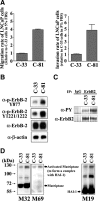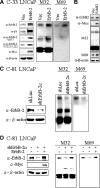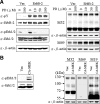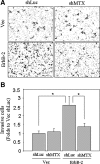Matriptase is involved in ErbB-2-induced prostate cancer cell invasion
- PMID: 20971737
- PMCID: PMC2993294
- DOI: 10.2353/ajpath.2010.100228
Matriptase is involved in ErbB-2-induced prostate cancer cell invasion
Abstract
Deregulation of both ErbB-2 signaling and matriptase activity has been associated with human prostate cancer (PCa) progression. In this communication, we investigated the roles of both ErbB-2 signaling in matriptase zymogen activation and matriptase in ErbB-2-induced PCa malignancy. In a human PCa cell progression model, we observed that advanced PCa C-81 LNCaP cells exhibited an aggressive phenotype with increased cell migration and invasion capacity; these cells concurrently showed both enhanced ErbB-2 phosphorylation and increased matriptase zymogen activation compared with parental C-33 LNCaP cells. Moreover, ErbB2 activation, both ligand-dependent (eg, epidermal growth factor treatment) and ligand-independent (eg, overexpression), was able to induce matriptase zymogen activation in this cell line. Inhibition of ErbB-2 activity by either the specific inhibitor, AG825, in epidermal growth factor-treated C-33 LNCaP cells or ErbB-2 knockdown in C-81 LNCaP cells, reduced matriptase activation. These observations were confirmed by similar studies using both DU145 and PC3 cells. Together, these data suggest that ErbB-2 signaling plays an important role in matriptase zymogen activation. ErbB-2-enhanced matriptase activation was suppressed by a phosphatidylinositol 3-kinase inhibitor (ie, LY294002) but not by a MEK inhibitor (ie, PD98059). Suppression of matriptase expression by small hairpin RNA knockdown in ErbB-2-overexpressing LNCaP cells dramatically suppressed cancer cell invasion. In summary, our data indicate that ErbB-2 signaling via the phosphatidylinositol 3-kinase pathway results in up-regulated matriptase zymogen activity, which contributes to PCa cell invasion.
Figures








Similar articles
-
Curcumin-targeting pericellular serine protease matriptase role in suppression of prostate cancer cell invasion, tumor growth, and metastasis.Cancer Prev Res (Phila). 2013 May;6(5):495-505. doi: 10.1158/1940-6207.CAPR-12-0293-T. Epub 2013 Mar 6. Cancer Prev Res (Phila). 2013. PMID: 23466486
-
Inhibition of cyclooxygenase-2-mediated matriptase activation contributes to the suppression of prostate cancer cell motility and metastasis.Oncogene. 2017 Aug 10;36(32):4597-4609. doi: 10.1038/onc.2017.82. Epub 2017 Apr 3. Oncogene. 2017. PMID: 28368394
-
Androgen-Induced TMPRSS2 Activates Matriptase and Promotes Extracellular Matrix Degradation, Prostate Cancer Cell Invasion, Tumor Growth, and Metastasis.Cancer Res. 2015 Jul 15;75(14):2949-60. doi: 10.1158/0008-5472.CAN-14-3297. Epub 2015 May 27. Cancer Res. 2015. PMID: 26018085
-
HAI-2 suppresses the invasive growth and metastasis of prostate cancer through regulation of matriptase.Oncogene. 2014 Sep 18;33(38):4643-52. doi: 10.1038/onc.2013.412. Epub 2013 Oct 14. Oncogene. 2014. PMID: 24121274 Free PMC article.
-
Matriptase and its putative role in cancer.Cell Mol Life Sci. 2006 Dec;63(24):2968-78. doi: 10.1007/s00018-006-6298-x. Cell Mol Life Sci. 2006. PMID: 17131055 Free PMC article. Review.
Cited by
-
The host microenvironment influences prostate cancer invasion, systemic spread, bone colonization, and osteoblastic metastasis.Front Oncol. 2014 Dec 15;4:364. doi: 10.3389/fonc.2014.00364. eCollection 2014. Front Oncol. 2014. PMID: 25566502 Free PMC article. Review.
-
3-Cl-AHPC inhibits pro-HGF maturation by inducing matriptase/HAI-1 complex formation.J Cell Mol Med. 2019 Jan;23(1):155-166. doi: 10.1111/jcmm.13900. Epub 2018 Oct 28. J Cell Mol Med. 2019. PMID: 30370662 Free PMC article.
-
A pan-cancer analysis of alternative splicing events reveals novel tumor-associated splice variants of matriptase.Cancer Inform. 2014 Dec 4;13:167-77. doi: 10.4137/CIN.S19435. eCollection 2014. Cancer Inform. 2014. PMID: 25506199 Free PMC article.
-
A JUN N-terminal kinase inhibitor induces ectodomain shedding of the cancer-associated membrane protease Prss14/epithin via protein kinase CβII.J Biol Chem. 2020 May 15;295(20):7168-7177. doi: 10.1074/jbc.RA119.011206. Epub 2020 Apr 2. J Biol Chem. 2020. PMID: 32241917 Free PMC article.
-
MicroRNA-125b down-regulation mediates endometrial cancer invasion by targeting ERBB2.Med Sci Monit. 2012 Apr;18(4):BR149-55. doi: 10.12659/msm.882617. Med Sci Monit. 2012. PMID: 22460089 Free PMC article.
References
-
- Chen CJ, You SL, Lin LH, Hsu WL, Yang YW. Cancer epidemiology and control in Taiwan: a brief review. Jpn J Clin Oncol. 2002;32 Suppl:S66–S81. - PubMed
-
- Jemal A, Siegel R, Ward E, Murray T, Xu J, Thun MJ. Cancer statistics, 2007. CA Cancer J Clin. 2007;57:43–66. - PubMed
-
- Sporn MB. The war on cancer. Lancet. 1996;347:1377–1381. - PubMed
-
- Stetler-Stevenson WG, Aznavoorian S, Liotta LA. Tumor cell interactions with the extracellular matrix during invasion and metastasis. Annu Rev Cell Biol. 1993;9:541–573. - PubMed
-
- Carles J, Lloreta J, Salido M, Font A, Suarez M, Baena V, Nogue M, Domenech M, Fabregat X. Her-2/neu expression in prostate cancer: a dynamic process? Clin Cancer Res. 2004;10:4742–4745. - PubMed
Publication types
MeSH terms
Substances
Grants and funding
LinkOut - more resources
Full Text Sources
Other Literature Sources
Medical
Research Materials
Miscellaneous

